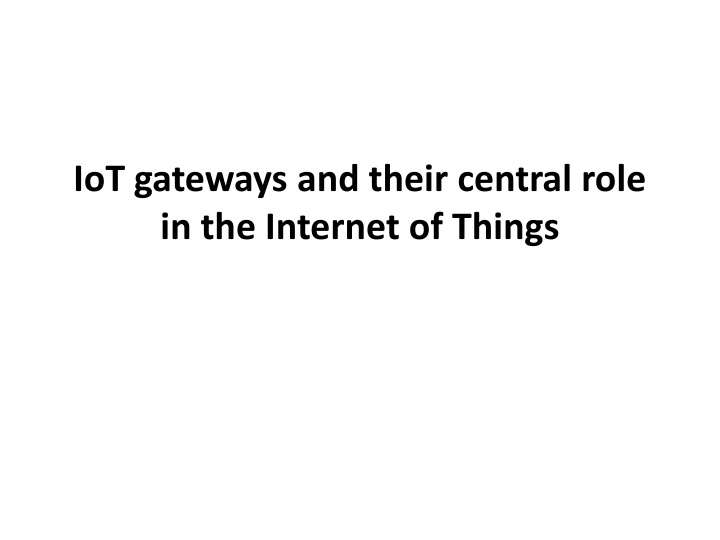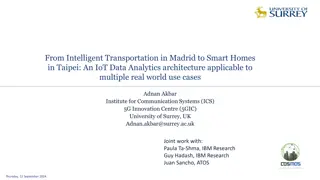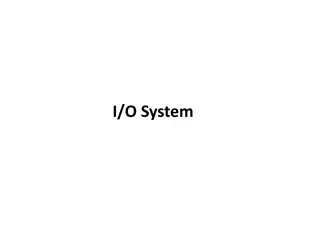
The Central Role of IoT Gateways in Interconnecting Devices
In the Internet of Things ecosystem, IoT gateways play a critical role by bridging communication between various sensors, devices, networks, and the Internet. These gateways facilitate interoperability, data aggregation, protocol translation, and local data processing before transmission to cloud systems. Explore the core functions and benefits of IoT gateways in seamlessly connecting different technologies within IoT environments.
Download Presentation

Please find below an Image/Link to download the presentation.
The content on the website is provided AS IS for your information and personal use only. It may not be sold, licensed, or shared on other websites without obtaining consent from the author. If you encounter any issues during the download, it is possible that the publisher has removed the file from their server.
You are allowed to download the files provided on this website for personal or commercial use, subject to the condition that they are used lawfully. All files are the property of their respective owners.
The content on the website is provided AS IS for your information and personal use only. It may not be sold, licensed, or shared on other websites without obtaining consent from the author.
E N D
Presentation Transcript
IoT gateways and their central role in the Internet of Things
In the Internet of Things, IoT gateways provide an interface between old and new sensors, devices, networks and nodes.
What are IoT gateways? In telecommunications, the primary purpose of a gateway is to provide a bridge between different types of communication technologies. These can differ in terms of connection types, interfaces, or protocols. For example, your home Internet gateway connects your Local Area Network (LAN) to your Internet Service Provider (ISP). This gateway connects the ISP s Wide Area Network (WAN) to your LAN using TCP/IP. The IoT gateway follows the same principle of bridging communication for different technologies. It creates a bridge between the IoT sensors / actuators and the Internet. The IoT gateway aggregates data, if necessary, translates the protocols of the sensors and processes the data before transmission.
Fig. 2 IoT gateways as a bridge between Things and the Internet.
The IoT gateway handles all communication between the sensors, devices in the field and remote connections such as the Internet, applications, or users. In this communication, the IoT gateways collect the data locally and then usually send it via MQTT or AMQP to a cloud system such as Azure or AWS.
What are IoT gateways needed for? IoT gateways bring a wide variety of benefits in the context of the Internet of Things. The following three points summarise the core functions. Central core functions of IoT gateways
Interoperability Equipped with a wide variety of interfaces, protocols, and standards, for example for local installation (edge) or remote data transmission via fixed and mobile networks (connectivity), IoT gateways simplify the collaboration of many different old and new devices in an IoT scenario. They transmit the collected data to the internet or to a central IoT platform or cloud architecture. In this way, they reduce the technical complexity of the systems and keep the necessary investment costs low.
Concentrator In an IoT system, several sensors or devices are connected to an IoT gateway, which interconnects and transports them with suitable protocols via fixed and/or mobile radio links in the field to form a data stream. This concentration of data achieves both economic effects, e.g., using only one SIM card and a cost-intensive hardware module for the mobile radio link, and effects for IT security, since only the IoT gateway can be reached via the IP address space but not all devices or sensors.
Local data processing An IoT gateway also plays a central role in the context of local data pre-processing. This involves, for example, filtering data that is only transmitted in the event of relevant changes, e.g., when limit values are reached and not continuously. This leads to a significant reduction in the amount of data and the associated operating costs. This function is also useful for triggering a direct, local action without an existing connection to the central platform. In this context, full-fledged analysis programmes are increasingly used as so-called stream analytics in the edge, which trigger the defined requirements for computing and storage power. The connection to public cloud systems is also frequently enabled via corresponding software programmes that are operated on the gateway. In addition, gateways sometimes also serve as trust points , i.e. as communication anchors in the edge. In this way, they contribute to the highest possible security of IoT cloud communication.
https://www.welotec.com/iot-gateways-and- their-central-role-in-the-internet-of-things/
Front-end EDGE devices are hardware components that reside at the edge of a network and serve as an interface between the end-user devices and the network infrastructure. These devices are commonly found in various domains, including IoT (Internet of Things), industrial automation, smart homes, and edge computing environments. The primary function of front-end EDGE devices is to collect, process, and transmit data from end-user devices to the network or cloud services. They often feature connectivity options such as Wi-Fi, Bluetooth, Zigbee, or cellular networks, enabling seamless communication with a wide range of devices. Integration with cloud platforms or edge computing frameworks allows seamless data transfer, storage, and analysis, enabling advanced applications such as remote monitoring, predictive maintenance, or intelligent automation.
Front-end EDGE devices typically incorporate sensors or actuators to interface with the physical world. They can gather data from sensors, such as temperature, humidity, motion, or light sensors, and control actuators like motors, relays, or displays. These devices are designed to be low-power, compact, and suitable for deployment in resource-constrained environments. Front-end EDGE devices often run specialized firmware or software stacks tailored to their specific application domain. They may include real-time operating systems (RTOS), embedded Linux distributions, or custom firmware developed using programming languages such as C/C++.
Edge computing capabilities are commonly integrated into front-end EDGE devices, enabling local data processing and analytics. This helps reduce latency, bandwidth usage, and dependency on cloud services. Security is a crucial aspect of front-end EDGE devices. They may include features such as secure boot, data encryption, authentication mechanisms, and firmware update capabilities to ensure the integrity and confidentiality of data.
Front-end EDGE devices are a fundamental component of the edge computing architecture, enabling distributed intelligence and enabling real-time decision-making at the network edge. The market for front-end EDGE devices is rapidly evolving with advancements in IoT, industry 4.0, and smart infrastructure. The focus is on enhancing connectivity, processing power, energy efficiency, and scalability to support a diverse range of applications. Examples of front-end EDGE devices include IoT gateways, smart sensors, embedded systems, edge servers, and industrial control devices. These notes provide an overview of front-end EDGE devices and their significance in various domains. They highlight their functionality, connectivity options, edge computing capabilities, security considerations, and integration with cloud services.






















